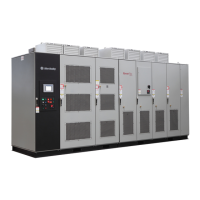Rockwell Automation Publication 6000-TD004D-EN-P - November 2017 17
Functional Descriptions Chapter 1
Trends
There are two kinds of dynamic trends available for PowerFlex 6000. The first
type of trend cannot be changed but can save history data. It can only show the
output voltage, output current and output frequency. The second type of trend
can be configured but cannot save the history data. It can show output frequency,
output voltage, motor estimated speed, output current, average DC voltage,
maximum DC voltage and minimum DC voltage by drawing curves of this status
data.
For the first type of trend, no configuration is required. For the second type of
trend, you can configure the parameter to display. Trends curves are showed by
the percentage value. For more details, see the PowerFlex 6000 Medium Voltage
Variable Frequency Drive User Manual(6000-UM002
).
VF Curve Setting
This function is designed to calculate the drive's output voltage according to the
set frequency. There are six kinds of V/F curves available – linear, curve, straight-
curve, parabolic-curve, 5 point VF, and SVC. Compensation voltage can be set to
improve the lower frequency start torque.
When a linear, curve, straight-curve, parabolic-curve, or SVC is selected, set the
parameters Low Speed Voltage Compensation (P451) and Low Speed Voltage
Compensation Frequency Threshold (P452). If the output frequency is lower than
the value of Low Speed Voltage Compensation Frequency Threshold, the output
voltage will be improved by the percentage value set in Low Speed Voltage
Compensation to enhance the output torque. If SVC is selected, the above
parameters need to be set based on the field conditions.
When VF curve is selected, the five points are defined based on their load curve.
These five points are Point 1 (f1, V1), Point 2 (f2, V2), Point 3 (f3, V3), Point 4
(f4, V4), and Point 5 (f5, V5).
The following parameters are used to define the five points:
• f1 = Frequency At First Point For 5 Point VF (P375)
• V1 = Amplitude At First Point For 5 Point VF (P376)
• f2 = Frequency At Second Point For 5 Point VF (P377)
• V2 = Amplitude At Second Point For 5 Point VF (P378)
• f3 = Frequency At Third Point For 5 Point VF (P379)
• V3 = Amplitude At Third Point For 5 Point VF (P380)
• f4 = Frequency At Fourth Point For 5 Point VF (P381)
• V4 = Amplitude At Fourth Point For 5 Point VF (P382)
• f5 = Frequency At Fifth Point For 5 Point VF (P383)
• V5 = Amplitude At Fifth Point For 5 Point VF (P384)

